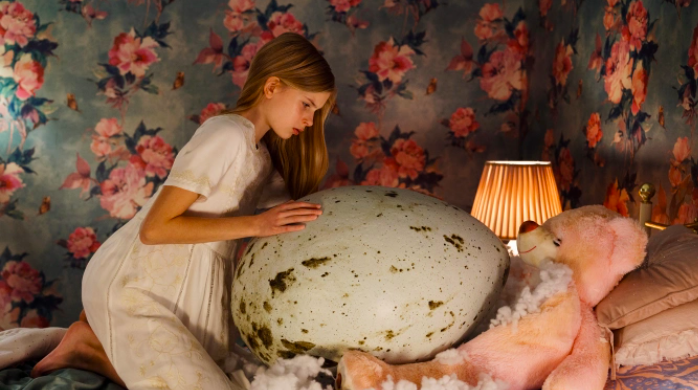
Finnish film director and screenwriter, Hanna Bergholm, debuts Hatching as her first feature film at Sundance Film Festival 2022. The original concept held a young boy at its centre, but Bergholm pushed for a female lead having noticed the lack of female protagonists in horror. Body horrors revolving around female puberty, motherhood, and feminine struggles outside of the male gaze and lopsided horror tropes like ‘the final girl’ and ‘damsel in distress’ are ones slowly, but thankfully, on the rise (kudos to our mate Bechdel; the monster under the red carpet). From the ashes of 1976 Carrie, we’ve seen exciting additions like Julia Ducournau’s Titane (2021) and Raw (2016). There has been massive recent success in this genre but, the question now is; is Hatching another success?
Tinja is a 12-year-old girl unlike the rest. Her and her family project perpetual perfection through the guise of her controlling, idealistic mother who documents their lives through an online blog. While the other girls socialise and lead regular lives, Tinja is wreaked with the heavy burden of her image obsessed mother to be the best picture-perfect gymnast. After discovering a lonely egg in the woods one night, Tinja secretly nurtures and raises the egg in her bedroom. Growing to an obscenely abnormal size, the egg hatches to reveal a dishevelled creature that becomes Tinjas child and waking horror.
Hatching uses the nuclear family, Pleasantville-esque trope of the white picket fenced family perceived perfect, but is unsurprisingly dysfunctional and a little deranged in actuality. With this image centric obsession, comes the satirical comments on social media culture. Through hitting the zeitgeist, I feel it misses its audience. We’ve seen an influx of social media commentary in cinema over the last decade, specifically within the past few years due to COVID, that it seems to be the same conversation on repeat to the point where its off-putting, especially if it’s an obvious element in the film. Beside the social media commentary, the nuclear family trope works well with the genre. The odious creature hatched from the egg immediately contrasts the environment and inhabitants it’s intruding upon. This creature represents all the things the mother dislikes and all the things the daughter represses, and this is shown clear through visual language alone. The creature is ugly, slimy, potent, misshapen, and disobedient; everything the mother made her daughter harshly contrast. The creature is impulsive, raging, violent, and disobedient; everything Tinja represses within herself because of her mother.
This film seems to heavily involve the idea and usage of mirrors and mirroring, which is commonly known to symbolise and represent truth. The son mirrors his father and Tinja mirrors her mother like they are extensions of each other. The constant filming of themselves for the online blog is yet another example of a mirror self. Bergholm also utilises shots where the camera is pointed to the mirror to witness action, specifically used when dealing with the creature. Even the creature itself is mirroring Tinja. The first evidence of this is actually in their first interaction with each other where Tinja covers her eyes with her hand, only to see the creature is doing the same. It seems as though the film comments upon needing to accept and love the imperfect side of oneself instead of rejecting and repressing. This creature is a physical reincarnation of Tinjas ‘imperfect’ self. Tinja hides it, she supresses it from everyone, but she can’t get rid of it because it’s part of her. So, she cares for it, tries to nurture it despite it being destructive. She can’t discard this part of herself. She sympathises with it and tries to love it. It’s strange to conceptualise self-neglect as a living creature, but it compliments a body horror story of pubescent and image struggles.
Despite its smart mirroring, the film overall lacks in a lot of areas. With the runtime of 91 minutes, it still manages to drag and lose traction. Scarcity of tension and suspense to be boiled down to a protagonist being so calm that tension is nearly non-existent. Insufferable characters with either no assertion, or overbearing assertion, gives audiences minimal space for connection, sympathy, or care for these characters safety. Our one saving grace for raising stakes is a character with 10 minutes of screentime. An unfortunate neglect. The film also leant heavily into abstraction, making it psychological and thought provoking than visually shocking, which didn’t help with the already lack of suspense.
Siiri Solalinna made her acting debut as both Tinja and the creature with unbelievable talent and range. Her ability to portray two vastly opposing characters, especially one deranged and inhuman as it was, is noteworthy to say the least. Most children fear the monster under their bed, but this young girl welcomes it with open arms. Giving Darren Aronofsky’s identity collapse and perfection overhaul of Black Swan, but the unfortunate zest of Paradise Hills, Hatching could have been so much more than what it was.
Chloe Bobbin
